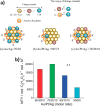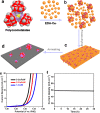Heterogeneous Trimetallic Nanoparticles as Catalysts
- PMID: 35263103
- PMCID: PMC8949769
- DOI: 10.1021/acs.chemrev.1c00493
Heterogeneous Trimetallic Nanoparticles as Catalysts
Abstract
The development and application of trimetallic nanoparticles continues to accelerate rapidly as a result of advances in materials design, synthetic control, and reaction characterization. Following the technological successes of multicomponent materials in automotive exhausts and photovoltaics, synergistic effects are now accessible through the careful preparation of multielement particles, presenting exciting opportunities in the field of catalysis. In this review, we explore the methods currently used in the design, synthesis, analysis, and application of trimetallic nanoparticles across both the experimental and computational realms and provide a critical perspective on the emergent field of trimetallic nanocatalysts. Trimetallic nanoparticles are typically supported on high-surface-area metal oxides for catalytic applications, synthesized via preparative conditions that are comparable to those applied for mono- and bimetallic nanoparticles. However, controlled elemental segregation and subsequent characterization remain challenging because of the heterogeneous nature of the systems. The multielement composition exhibits beneficial synergy for important oxidation, dehydrogenation, and hydrogenation reactions; in some cases, this is realized through higher selectivity, while activity improvements are also observed. However, challenges related to identifying and harnessing influential characteristics for maximum productivity remain. Computation provides support for the experimental endeavors, for example in electrocatalysis, and a clear need is identified for the marriage of simulation, with respect to both combinatorial element screening and optimal reaction design, to experiment in order to maximize productivity from this nascent field. Clear challenges remain with respect to identifying, making, and applying trimetallic catalysts efficiently, but the foundations are now visible, and the outlook is strong for this exciting chemical field.
Conflict of interest statement
The authors declare no competing financial interest.
Figures





























Similar articles
-
Metal Nanoparticles Immobilized on Molecularly Modified Surfaces: Versatile Catalytic Systems for Controlled Hydrogenation and Hydrogenolysis.Acc Chem Res. 2021 May 4;54(9):2144-2157. doi: 10.1021/acs.accounts.1c00013. Epub 2021 Apr 6. Acc Chem Res. 2021. PMID: 33822579 Free PMC article.
-
Rational Design of Pt-Pd-Ni Trimetallic Nanocatalysts for Room-Temperature Benzaldehyde and Styrene Hydrogenation.Chem Asian J. 2021 Aug 16;16(16):2298-2306. doi: 10.1002/asia.202100472. Epub 2021 Jun 30. Chem Asian J. 2021. PMID: 34156156
-
Interface-confined oxide nanostructures for catalytic oxidation reactions.Acc Chem Res. 2013 Aug 20;46(8):1692-701. doi: 10.1021/ar300249b. Epub 2013 Mar 4. Acc Chem Res. 2013. PMID: 23458033
-
Revolution from monometallic to trimetallic nanoparticle composites, various synthesis methods and their applications: A review.Mater Sci Eng C Mater Biol Appl. 2017 Feb 1;71:1216-1230. doi: 10.1016/j.msec.2016.11.002. Epub 2016 Nov 5. Mater Sci Eng C Mater Biol Appl. 2017. PMID: 27987678 Review.
-
Carbon-supported palladium and ruthenium nanoparticles: application as catalysts in alcohol oxidation, cross-coupling and hydrogenation reactions.Recent Pat Nanotechnol. 2013 Nov;7(3):247-64. doi: 10.2174/187221050703131127110716. Recent Pat Nanotechnol. 2013. PMID: 22946626 Review.
Cited by
-
Bimetallic Sites for Catalysis: From Binuclear Metal Sites to Bimetallic Nanoclusters and Nanoparticles.Chem Rev. 2023 Apr 26;123(8):4855-4933. doi: 10.1021/acs.chemrev.2c00733. Epub 2023 Mar 27. Chem Rev. 2023. PMID: 36971499 Free PMC article. Review.
-
Gold-iron oxide (Au/Fe3O4) magnetic nanoparticles as the nanoplatform for binding of bioactive molecules through self-assembly.Front Mol Biosci. 2023 Mar 27;10:1143190. doi: 10.3389/fmolb.2023.1143190. eCollection 2023. Front Mol Biosci. 2023. PMID: 37051321 Free PMC article.
-
Synthetic control over lattice strain in trimetallic AuCu-core Pt-shell nanoparticles.Nanoscale. 2025 Mar 24;17(12):7100-7113. doi: 10.1039/d4nr04424j. Nanoscale. 2025. PMID: 39903214 Free PMC article.
-
A new sandwich-type electrochemiluminescence sensor based on HPSNs-NH2@Au NPs and AuPdPt NPs for determination of α(2,3)-sial-Gs.Mikrochim Acta. 2023 Sep 28;190(10):420. doi: 10.1007/s00604-023-06000-w. Mikrochim Acta. 2023. PMID: 37770767
-
Mesoporous multimetallic nanospheres with exposed highly entropic alloy sites.Nat Commun. 2023 Jul 13;14(1):4182. doi: 10.1038/s41467-023-39157-2. Nat Commun. 2023. PMID: 37443103 Free PMC article.
References
-
- Chalmin E.; Menu M.; Vignaud C. Analysis of Rock Art Painting and Technology of Palaeolithic Painters. Meas. Sci. Technol. 2003, 14, 1590–1597. 10.1088/0957-0233/14/9/310. - DOI
-
- Mohan Bhagyaraj S.; Oluwafemi O. S.. Nanotechnology: The Science of the Invisible. In Synthesis of Inorganic Nanomaterials; Elsevier, 2018; pp 1–18.10.1016/B978-0-08-101975-7.00001-4. - DOI
-
- Brun N.; Mazerolles L.; Pernot M. Microstructure of Opaque Red Glass Containing Copper. J. Mater. Sci. Lett. 1991, 10, 1418–1420. 10.1007/BF00735696. - DOI
-
- Khawaji M.; Chadwick D. Selective Catalytic Oxidation over Au-Pd/Titanate Nanotubes and the Influence of the Catalyst Preparation Method on the Activity. Catal. Today 2019, 334, 122–130. 10.1016/j.cattod.2018.11.080. - DOI
-
- Sun Y.; Mayers B.; Xia Y. Metal Nanostructures with Hollow Interiors. Adv. Mater. 2003, 15, 641–646. 10.1002/adma.200301639. - DOI
Publication types
MeSH terms
Substances
Grants and funding
LinkOut - more resources
Full Text Sources
Other Literature Sources

